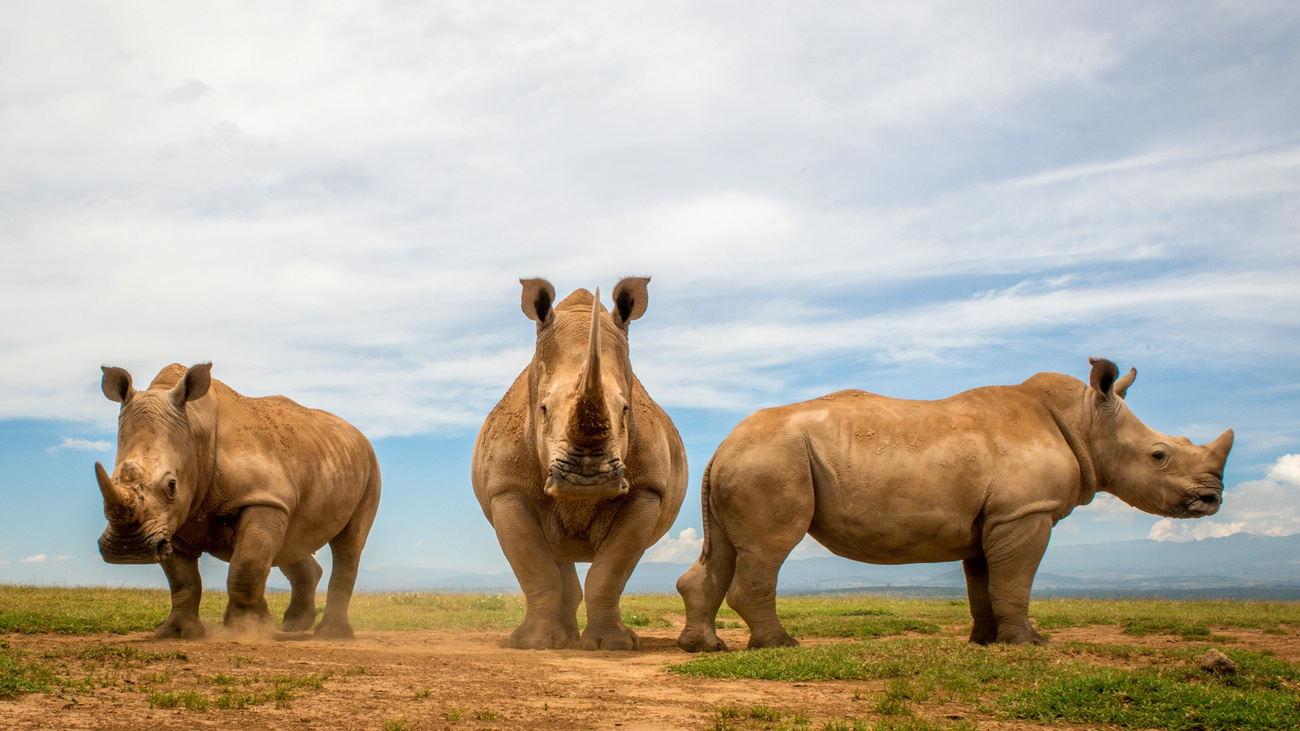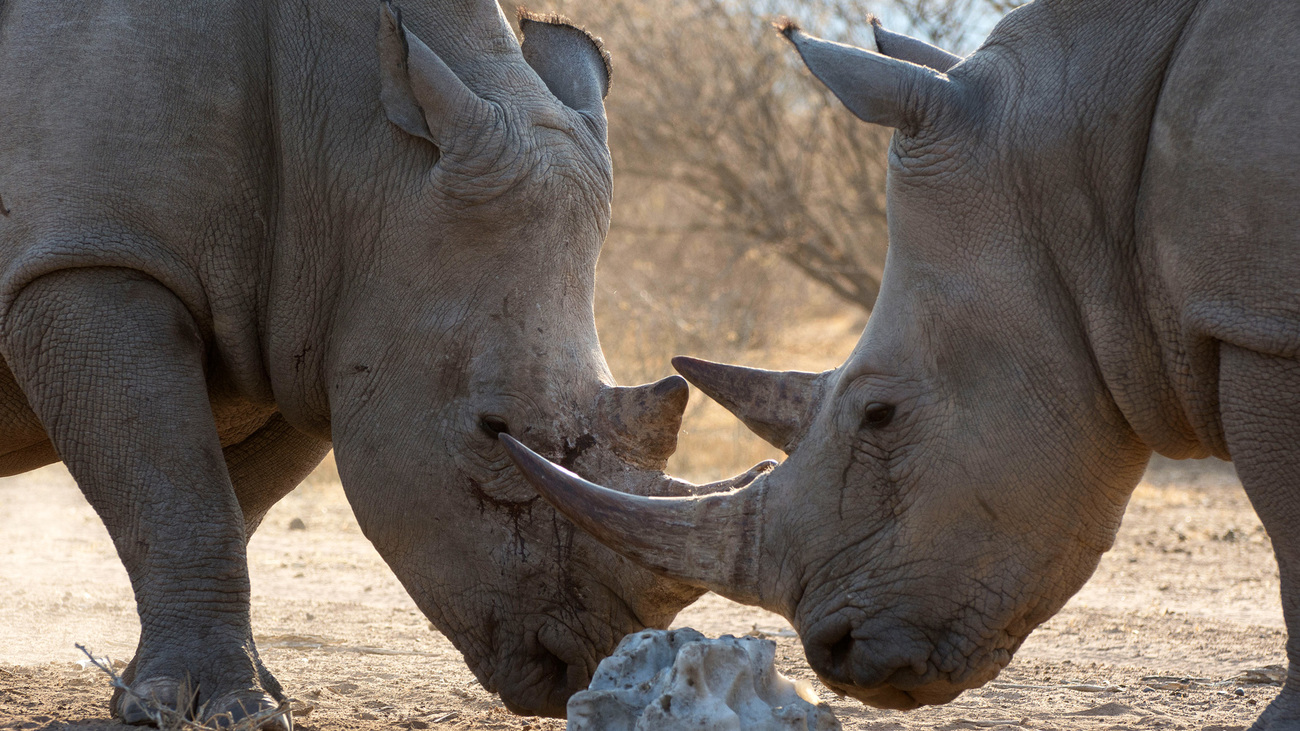White rhinos
The white rhinoceros of Africa, scientifically known as Ceratotherium simum, can be divided into two subspecies: the northern white rhinoceros (Ceratotherium simum cottoni) and the southern white rhinoceros (Ceratotherium simum simum). As the name suggests, northern white rhinos live further north—currently residing in Kenya thanks to assisted colonization, though their historic range spanned from Chad and Sudan to the Democratic Republic of the Congo—while southern white rhinos occupy southern Africa.
However, despite their name, white rhinos aren’t white in color. Just like their cousins, black rhinos, they’re actually grey. It’s thought that the name ‘white’ may have derived from the Afrikaans word ‘weit’, which means ‘wide’ and refers to their broad, square-shaped mouths.
These wide mouths are perfectly adapted to their diet. As herbivores, the white rhino’s diet is mainly made up of a variety of grasses found in their grassland and savannah habitats. They tend to prefer short grasses of around 7 to 10 centimeters (3 to 4 inches) tall and use their square-shaped lips to crop the grass close to the ground.
White rhinos are the second-largest land mammals after elephants. Male white rhinos are noticeably larger than females, ranging from 3.7 to 4 meters (12 to 13 feet) long and standing at 2 meters (7 feet) tall. Northern white rhinos tend to be lighter, smaller, and less hairy than southern white rhinos, though they have longer legs, shorter palates, and flatter skulls. The male southern white rhinoceros can weigh anywhere from 2,000 to 2,400 kilograms (4,400 to 5,300 pounds), while the male northern white rhino only weighs around 1,600 kilograms (3,500 pounds).
The white rhino is a semi-social and territorial creature. These rhinos are known to form herds of up to 12 individuals and mark their territory with dung, which they strategically place around the area they occupy. Males take on the role of defending the territory—they use their horns and large size to their advantage in a fight. They’re also known to be more solitary than female rhinos. A male white rhino will stick to roughly one square mile of land, while a female prefers to venture out by about seven square miles, her calf remaining close by her side. However, dominant males prevent breeding females from leaving their territory by marking and guarding them. When competing for female white rhinos, males can get into aggressive fights until one is the champion.
Male and female white rhinos reach sexual maturity at different ages. Females are sexually mature at around age four or five, while males can take up to an extra five years, beginning breeding at 10 years old. The gestation period for a white rhino is one of the longest in the animal kingdom—it lasts approximately 16 months. After this time, a female white rhino will birth a single calf. Breeding occurs throughout the year for this species, though females will only give birth every three to four years. White rhino calves tend to stay with their mothers for several years to learn essential survival skills before becoming independent. Both northern and southern white rhinos have a lifespan of up to 50 years in the wild, while some captive white rhinos have lived to 55 years old.
White rhinos can often be found either resting under shade trees or rolling around in the wet mud, coating their entire bodies. This helps keep them cool from the high temperatures of their habitat and protects their skin from the sun and insects.
White rhinos are a keystone species that have a huge impact on their ecosystem in various ways. They’re key to the creation and maintenance of waterholes, which they create by rolling around in the mud. As they wallow in waterholes, they wash mud off their bodies, which helps distribute fertile soil in the surrounding areas. These waterholes benefit other creatures, including antelopes, who can drink from these water sources without risking getting stuck in the mud.
Through their eating habits, rhinos establish and maintain short-grass ‘lawns’ which are crucial for certain plant and animal species that cannot survive in wooded or long-grass ecosystems. Every day, a white rhino consumes over 50 kilograms (110 pounds) of vegetation and deposits more than 20 kilograms (44 pounds) of dung, further enriching the soil. This dung supports its own diverse food chain, involving dung beetles, slender mongooses, and birds like crested guineafowl.
White rhinos are also important to the local economy. As one of the Big Five animals, they play a crucial role in ecotourism. They’re a highlight for tourists to see on safari trips, particularly due to their easy visibility and territorial behavior.
Sadly, the northern white rhino is one of the most endangered species in the world. Only two remain out of the entire population, a mother and daughter called Najin and Fatu. To prevent the subspecies from going extinct, conservationists are working on techniques to create new northern white rhino embryos. One technique would include harvesting viable eggs from the remaining females and fertilizing them with sperm previously collected from male northern white rhinos.
In the late 19th century, it was also thought that southern white rhinos were extinct. Thankfully, a small population of around 100 were discovered in South Africa. After immense conservation efforts, southern white rhinos are now classified as ‘near threatened’. This speaks to the importance of learning about how to conserve these animals to increase their populations.
What is a white rhino’s scientific name?
The scientific name for the white rhino is Ceratotherium simum. The northern white rhino’s scientific name is Ceratotherium simum cottoni, while a southern white rhino’s scientific name is Ceratotherium simum simum.
Are white rhinos endangered?
On the IUCN Red List, the white rhino is classified as near threatened. There are an estimated 10,080 mature individuals left in the world, and their population is decreasing.
However, the northern white rhino subspecies is classified as critically endangered. Sadly, only two northern white rhinos remain in the world, living in Kenya’s Ol Pejeta Conservancy. Their population is declining, and because both remaining individuals are female, conservation efforts are urgently needed to ensure their survival.
The southern white rhino is considered near threatened, with just over 10,000 individuals remaining in South Africa. Despite strong conservation efforts, the IUCN estimates that their populations are also decreasing.
Where do white rhinos live?
White rhinos are native to Africa, inhabiting the continent’s grasslands, shrublands, and savannahs. These herbivores are well adapted to their habitat, grazing on the shorter grasses and wallowing in the muddy waterholes.
Southern white rhinos are primarily found in southern African countries, with the vast majority in South Africa, Namibia, and Zimbabwe, while some also live in Kenya thanks to assisted colonization. Northern white rhinos were historically found in northern African countries, including the Democratic Republic of the Congo, South Sudan, Central African Republic, Chad, Sudan, and Uganda. However, only two of these critically endangered animals now exist. They live in Kenya’s Ol Pejeta Conservancy.
Threats
There are several threats to white rhinos’ survival, the most significant being poaching. Habitat loss, human-wildlife conflict, and climate change are also pressing factors contributing to their decreasing populations.

Poaching
The biggest threat to white rhinos is illegal hunting or poaching. Poachers target white rhinos for the international illegal rhino horn trade, primarily in Southeast Asia. Here, their horns are traditionally used in Chinese medicine and for decorative purposes. Poaching initially didn’t significantly impact the overall population of white rhinos in Africa, as the species’ growth rate matched their poaching losses. However, between 2007 and 2014, poaching activities saw a sharp incline and had a devastating impact on the white rhino population.
Habitat loss
The northern white rhino population was drastically reduced as a result of civil conflict within the Democratic Republic of the Congo and South Sudan. Around 2003, poaching activity increased, and the northern white rhino population was diminished. Nobody has spotted a live northern white rhino in either of these countries since 2006, and signs of dung haven’t been seen since 2007. Therefore, the Northern white rhino is believed to be extinct in the Democratic Republic of Congo and South Sudan.
Agricultural activities and expanding human settlements are also impacting white rhinos. These developments reduce the space available for rhinos to roam freely, which can isolate populations and obstruct breeding.
The growing proximity of humans to rhinos is also leading to an increase in the number of human-wildlife conflicts, which can result in injury or fatality for both sides. These conflicts can create negative perceptions of rhinos in local areas, which makes promoting conservation efforts more challenging.
Climate change
Climate change is having an indirect yet substantial impact on white rhinos, as it affects the quality and quantity of vegetation available as food sources. Droughts can also disrupt the natural behaviors of this species, which relies on the availability of waterholes for drinking and wallowing.
FAQs
Where do white rhinos live?
White rhinos are native to the grasslands and savannahs of Africa. Northern white rhinos were primarily found in northern and central African countries, including the Democratic Republic of the Congo and South Sudan. However, due to illegal poaching activities, only two remain and currently live in Kenya’s Ol Pejeta Conservancy.
Southern white rhinos are known to live in southern and East African countries, including South Africa, Kenya, Zimbabwe, and Namibia.
Why are white rhinos endangered?
While white rhinos face several threats, poaching is the biggest threat to their survival. They are hunted for their horns, which are illegally traded worldwide. Their horns are used in traditional Chinese medicine and as decorations.
How many white rhinos are left?
The total population of the white rhino is thought to be at 10,080, as of January 2020. The number of southern white rhinos is estimated to be around the same. There are only two northern white rhinos known to exist, living in Kenya’s Ol Pejeta Conservancy. Northern white rhinos are thought to be extinct everywhere else in the wild.
What is the difference between a white rhino and a black rhino?
Both the white and black rhino are actually grey in color. They differ mainly in size, as white rhinos are typically larger than black rhinos. White rhinos also have wider, square mouths, which are adapted to help them eat shorter grasses in the savannahs.

How long do white rhinos live for?
The white rhinoceros is known to live for up to 50 years in the wild and 55 years in captivity.
Will rhinos go extinct?
Since their populations are still decreasing, it is possible that if illegal poaching activities continue, white rhinos could go extinct.
How can you help?
If learning more about the white rhino has motivated you to help this threatened species, you’re in the right place. You can donate to conservation efforts for the white rhino today and learn more about the animals that IFAW works to protect.
